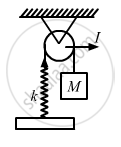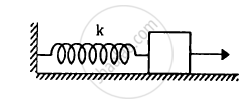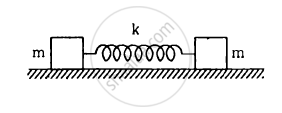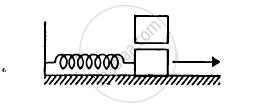Advertisements
Advertisements
Question
Solve the previous problem if the pulley has a moment of inertia I about its axis and the string does not slip over it.
Solution

Let us try to solve the problem using energy method.
If δ is the displacement from the mean position then, the initial extension of the spring from the mean position is given by,
\[\delta =\] \[\frac{mg}{k}\]
Let x be any position below the equilibrium during oscillation.
Let v be the velocity of mass m and ω be the angular velocity of the pulley.
If r is the radius of the pulley then
v = rω
As total energy remains constant for simple harmonic motion, we can write:
\[\frac{1}{2}M v^2 + \frac{1}{2}I \omega^2 + \frac{1}{2}k\left[ (x + \delta )^2 - \delta^2 \right] - Mgx = \text { Constant }\]
\[ \Rightarrow \frac{1}{2}M v^2 + \frac{1}{2}I \omega^2 + \frac{1}{2}k x^2 + kxd - Mgx = \text { Constant }\]
\[ \Rightarrow \frac{1}{2}M v^2 + \frac{1}{2}I\left( \frac{v^2}{r^2} \right) + \frac{1}{2}k x^2 = \text { Constant } \left[ \because \delta = \frac{Mg}{k} \right]\]
By taking derivatives with respect to t, on both sides, we have:
\[Mv . \frac{dv}{dt} + \frac{I}{r^2}v . \frac{dv}{dt} + kx\frac{dx}{dt} = 0\]
\[Mva + \frac{I}{r^2}va + kxv = 0 \left( \because v = \frac{dx}{dt} \text { and }a = \frac{dv}{dt} \right)\] \[a\left( M + \frac{I}{r^2} \right) = - kx \] \[ \Rightarrow \frac{a}{x} = \frac{k}{M + \frac{I}{r^2}} = \omega^2 \] \[T = \frac{2\pi}{\omega}\]
\[ \Rightarrow T = 2\pi\sqrt{\frac{M + \frac{I}{r^2}}{k}}\]
APPEARS IN
RELATED QUESTIONS
The maximum speed and acceleration of a particle executing simple harmonic motion are 10 cm/s and 50 cm/s2. Find the position(s) of the particle when the speed is 8 cm/s.
The equation of motion of a particle started at t = 0 is given by x = 5 sin (20t + π/3), where x is in centimetre and t in second. When does the particle
(a) first come to rest
(b) first have zero acceleration
(c) first have maximum speed?
Consider a particle moving in simple harmonic motion according to the equation x = 2.0 cos (50 πt + tan−1 0.75) where x is in centimetre and t in second. The motion is started at t = 0. (a) When does the particle come to rest for the first time? (b) When does he acceleration have its maximum magnitude for the first time? (c) When does the particle come to rest for the second time ?
The pendulum of a clock is replaced by a spring-mass system with the spring having spring constant 0.1 N/m. What mass should be attached to the spring?
A block suspended from a vertical spring is in equilibrium. Show that the extension of the spring equals the length of an equivalent simple pendulum, i.e., a pendulum having frequency same as that of the block.
The block of mass m1 shown in figure is fastened to the spring and the block of mass m2 is placed against it. (a) Find the compression of the spring in the equilibrium position. (b) The blocks are pushed a further distance (2/k) (m1 + m2)g sin θ against the spring and released. Find the position where the two blocks separate. (c) What is the common speed of blocks at the time of separation?

The spring shown in figure is unstretched when a man starts pulling on the cord. The mass of the block is M. If the man exerts a constant force F, find (a) the amplitude and the time period of the motion of the block, (b) the energy stored in the spring when the block passes through the equilibrium position and (c) the kinetic energy of the block at this position.

Find the elastic potential energy stored in each spring shown in figure, when the block is in equilibrium. Also find the time period of vertical oscillation of the block.
Consider the situation shown in figure . Show that if the blocks are displaced slightly in opposite direction and released, they will execute simple harmonic motion. Calculate the time period.

A 1 kg block is executing simple harmonic motion of amplitude 0.1 m on a smooth horizontal surface under the restoring force of a spring of spring constant 100 N/m. A block of mass 3 kg is gently placed on it at the instant it passes through the mean position. Assuming that the two blocks move together, find the frequency and the amplitude of the motion.

Discuss in detail the energy in simple harmonic motion.
Show that for a particle executing simple harmonic motion.
- the average value of kinetic energy is equal to the average value of potential energy.
- average potential energy = average kinetic energy = `1/2` (total energy)
Hint: average kinetic energy = <kinetic energy> = `1/"T" int_0^"T" ("Kinetic energy") "dt"` and
average potential energy = <potential energy> = `1/"T" int_0^"T" ("Potential energy") "dt"`
A body is executing simple harmonic motion with frequency ‘n’, the frequency of its potential energy is ______.
A body is performing S.H.M. Then its ______.
- average total energy per cycle is equal to its maximum kinetic energy.
- average kinetic energy per cycle is equal to half of its maximum kinetic energy.
- mean velocity over a complete cycle is equal to `2/π` times of its π maximum velocity.
- root mean square velocity is times of its maximum velocity `1/sqrt(2)`.
Find the displacement of a simple harmonic oscillator at which its P.E. is half of the maximum energy of the oscillator.
An object of mass 0.5 kg is executing a simple Harmonic motion. Its amplitude is 5 cm and the time period (T) is 0.2 s. What will be the potential energy of the object at an instant t = `T/4` s starting from the mean position? Assume that the initial phase of the oscillation is zero.
